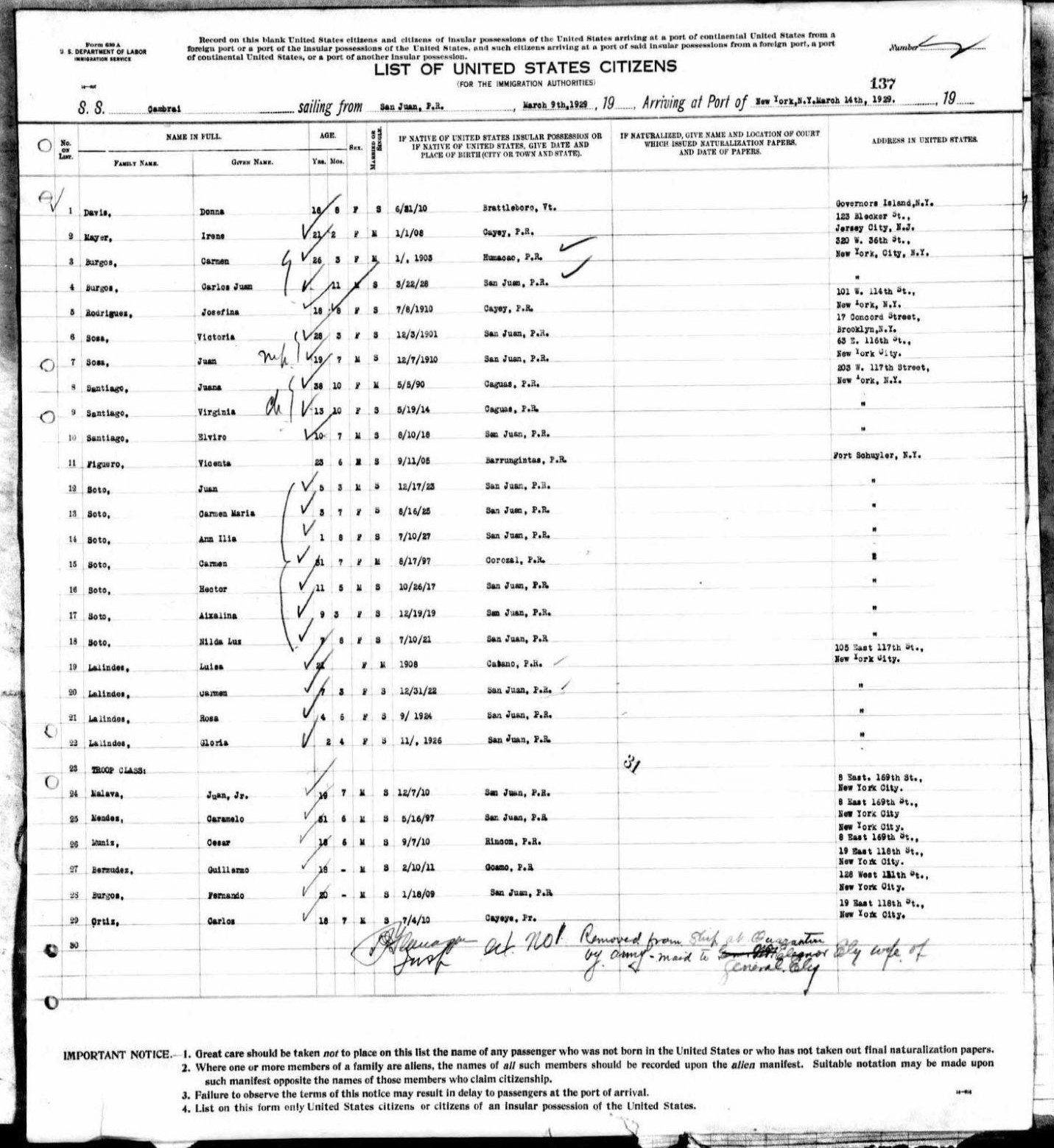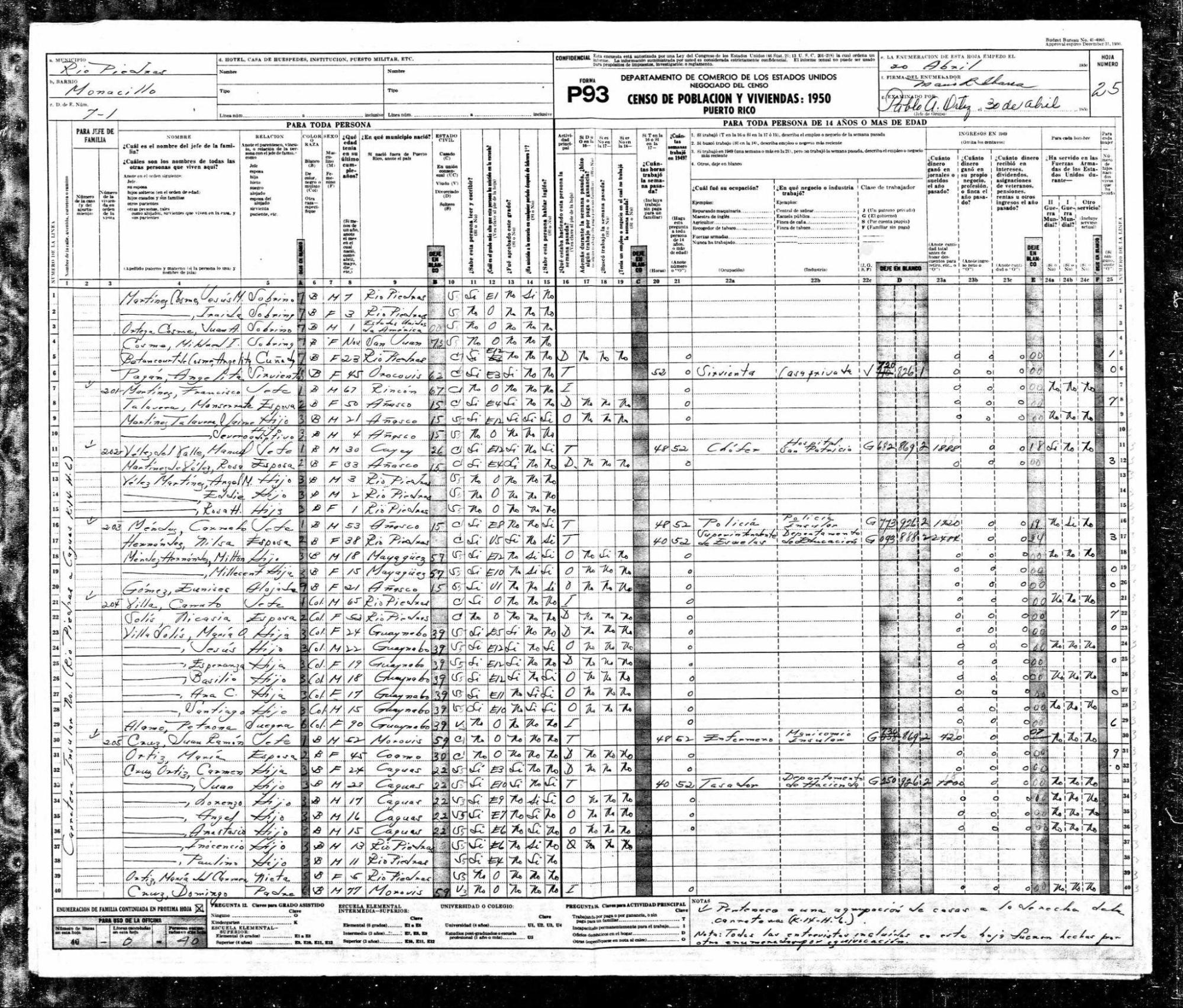Carmelo Mendez (May 16, 1897-June 27, 1997)
Pvt US Army
65th Infantry Regiment
By Melissa Rosero-Barros
Early Life
Carmelo Mendez served as a private in the US Armed Forces during the First World War.1 He was born Carmelo Mendez y Echevarria in Añasco, Puerto Rico on May 16, 1897 to his mother Isabel Echevarria y Soto and his father Patricio Mendez y Roman.2 Mendez had three siblings, two brothers named Jose and Francisco, and a sister named Mercedez. As a child, Mendez and his sister attended public school where they learned how to read and write in Spanish while their younger siblings stayed at home until they were of age to attend. The Mendez family lived an economically secure life despite the tumult that existed in Puerto Rico at the turn of the century, as evidenced by the fact that they owned their house with Patricio’s single income as a manager on a Sugar Cane farm.3
Mendez was born a year before Puerto Rico became a US territory. Mendez and his siblings grew up in the wake of almost a half-century of radical reforms as Puerto Rico chafed under Spanish colonial rule. Puerto Rico’s quest for autonomy came to a head with the pro-independence movement “Grito de Lares,” which saw many Puerto Ricans imprisoned in 1868.4 This movement continued into the creation of a short-lived independent Puerto Rico before the start of the Spanish-American War and the eventual re-creation of the island as a commonwealth under the jurisdiction of the United States. In 1900, as the US ratified the Foraker Law and created a civilian government, Mendez began his childhood in a Puerto Rico that exposed him to many different ideas of statehood and civil engagement.5
Military Service
On March 2, 1917, US President Woodrow Wilson signed the Jones-Shafroth Act separating Puerto Rico’s government into three branches and granting statutory American citizenship to all Puerto Ricans.6 A month later, the United States declared war on Germany– entering the First World War. Two months later, Wilson signed the Selective Service Act making most men from the ages of eighteen to forty-five eligible for the draft.7 Mendez joined the other 20,000 Puerto Ricans who served during the First World War.8
A year before the official draft started, Mendez enlisted in the US Army.9 There he served as a private under the leadership of his captain, Louis S. Emmanuelli.10 Like many others on the island, Mendez joined the Army’s 65th Infantry Regiment where he served in Company A.11 This regiment, known by the moniker “Borinqueneers,” a variation of a native Taino word meaning “Land of the Valiant Lord,” served in the Panama Canal to ensure that the Central Powers did not have access to it.12 Once back in Puerto Rico, Mendez lived on base Camp Las Casas with his company.13
Post Service Life
After his time in the military, Mendez married his wife, Juana Crespo y Ramos. They were married on January 1, 1920 in Añasco, Puerto Rico.14 The couple had two children, Esther, born in 1923, and William, born two years later.15
On September 13, 1928 the San Felipe Hurricane (also known as the 1928 Okeechobee Hurricane) ravaged Puerto Rico causing widespread destruction shortly before the Great Depression.16 A year later on March 4, 1929, Mendez traveled from Añasco, Puerto Rico to New York City on the USS Cambrai, as seen on the arriving passenger list to Ellis Island from 1929. Like many other Puerto Ricans during the period between 1928 and 1935, Mendez likely moved in search of work as Puerto Rico recovered.18 During this time, Mendez also divorced his first wife, Juana. He remarried a woman named Nilsa Hernandez– most likely meeting her while in New York as Nilsa lived in the city since her arrival in 1926.19 The couple moved back to Añasco, Puerto Rico in 1930.20 Together, they had three more children: Mildren, Milton, and Milisen.21
Despite Mendez eventually finding work as a police officer, the family of seven also housed several lodgers throughout the years to make ends meet.22 In 1935, two lodgers named Nieves Constanon and Anastasio Mendez (ages forty and twenty years old) lived with the family. During this period of financial crisis, the Mendezes moved from Añasco to Nilsa’s hometown of Rio Piedras.23 Nieves followed the family and stayed with them until 1940.24
The New Deal in Puerto Rico brought many programs that the island desperately needed after San Filipe and the 1932 hurricane San Ciprián. Among these programs, the ones which put money towards funding public schools in urban areas affected the Mendez family the most. Rio Piedras, the family’s new home, was much closer to San Juan and thus attracted many to move there from rural or agricultural-focused parts of the island (like Añasco).25 The influx of emigrants also contributed to the need for more oversight by the government–likely why Mendez became a police officer. According to the 1950 census, Nilsa had also begun working full-time, becoming a superintendent of the Monacillo public schools in Rio Piedras.26
At the start of the Second World War, Mendez was part of the men born between April 27,1877, and February 16, 1897 who qualified for what became known as “The Old Man's Registration.” While not a formal draft, the men who took part in it were given a questionnaire for use by the federal government. These questions gathered data on the skills of men considered too old for active military duty but potentially useful to the war effort.27
Some time after Nilsa passed in 1961, Mendez and some of their children moved to Florida.28 Mendez lived there until his own passing on June 27, 1997 after a hundred years of life. His loved ones laid him to rest on July 1, 1997 where he is buried at Florida National Cemetery in Bushnell, FL in section 412 site 780.29
Endnotes
1 UCF Veterans Legacy Program, Headstone for Carmelo Mendez, photograph, 2023, Florida National Cemetery, Bushnell, FL.
2 “Puerto Rico, Civil Registrations, 1885-2001,” database, Ancestry (ancestry.com: accessed April 20, 2023), entry for Carmelo Mendez Y Echevarria, Añasco, PR.; “1910 United States Federal Census,” database, Ancestry (ancestry.com: accessed April 19, 2023), entry for Carmelo Mendez Y Echevarria, Añasco, PR.
3 “1910 United States Federal Census,” database, Ancestry (ancestry.com: accessed April 19, 2023), entry for Patricio Mendez y Roman, Añasco, PR.; “1920 United States Federal Census,” database, Ancestry (ancestry.com: accessed April 19, 2023), entry for Patricio Mendez y Roman, San Juan, PR.
4 Marisabel Brás, “The Changing of the Guard: Puerto Rico in 1898,” Library of Congress, accessed February 22, 2024. https://guides.loc.gov/world-of-1898/puerto-rico-overview
5“Foraker Act (Organic Act of 1900),Library of Congress, accessed February 22, 2024. https://guides.loc.gov/world-of-1898/foraker-act
6 “Research Guides: A Latinx Resource Guide: Civil Rights Cases and Events in the United States: 1917: Jones-Shafroth Act,” Library of Congress, accessed March 12, 2024.
7 “H.R. 9533, An Act to provide a civil government for Porto Rico (Jones-Shafroth Act), June 30, 1916,” Artifact, explorethecapital.org, Accessed November 27, 2023. https://www.visitthecapitol.gov/artifact/hr-9533-act-provide-civil-government-porto-rico-jones-shafroth-act-june-30-1916
8 “A Latinx Resource Guide,” Library of Congress.
9 “Veterans Affairs BIRLS Death File,” database, Fold3 (fold3.com: accessed April 20, 2023), entry for Carmelo Mendez.
10 “1920 United States Federal Census,” database, Ancestry (ancestry.com: accessed April 19, 2023), entry for Carmelo Mendez, San Juan, PR.
11 “1920 United States Federal Census,” Ancestry. ; “U.S. Spanish American War Volunteers Index to Compiled Military Service Records, 1898,” database, Ancestry (ancestry.com: accessed February 28, 2024), entry for Corporal Yndalecio Lorenzo, PR.
12 Shannon Collins, “Puerto Ricans Represented Throughout U.S. Military History,” U.S. Department of Defense, accessed October 24, 2023, https://www.defense.gov/News/News-Stories/Article/Article/974518/puerto-ricans-represented-throughout-us-military-history/. ; Jacob M. henry, “The 65th Infantry Regiment,” National Museum of the United States Army, accessed March 4, 2024. https://www.thenmusa.org/articles/the-65th-infantry-regiment/
13 “1920 United States Federal Census,” Ancestry.; Col. D. W. Ketcham to War Department Chief of Staff, January 31, 1918, Office of the Chief of Staff, Name for the camp of the selective draft from Puerto Rico, Army Post Documents, United States Army, 040-Camp Casas-1918.
14 “Puerto Rico, Civil Registrations, 1885-2001,” database, Ancestry (ancestry.com: accessed April 19, 2023), entry for Carmelo Mendez Y Echavarría, Añasco, PR.
15 “Puerto Rico, U.S., Social and Population Schedules, 1935-1936,” database, Ancestry (ancestry.com: accessed April 19, 2023), entry for Carmelo Mendez, Añasco, PR.
16 Lieutenant Commander O. H. Hotmann, “A Hurricane in Puerto Rico,” U.S. Naval Institute, February 1933. Accessed March 12, 2024. https://www.usni.org/magazines/proceedings/1933/february/hurricane-puerto-rico
17 “New York, U.S., Arriving Passenger and Crew Lists (including Castle Garden and Ellis Island), 1820-1957,” database, Ancestry (ancestry.com: accessed April 19, 2023), entry for Carmelo Mendez, New York, NY.
18 “Puerto Rican Migration Before World War II,” Lehman College, Accessed March 12, 2024. https://lcw.lehman.edu/lehman/depts/latinampuertorican/latinoweb/PuertoRico/beforeww2.htm
19 “ New York, U.S., Arriving Passenger and Crew Lists (including Castle Garden and Ellis Island), 1820-1957,” database, Ancestry (ancestry.com: accessed April 19, 2023), entry for Nilsa A. Hernandez, New York, NY.
20 “U.S., Departing Passenger and Crew Lists, 1914-1966,” database, Ancestry (ancestry.com: accessed March 12, 2024), entry for Nilsa A. Hernandez, New York, NY.
21 “Puerto Rico, U.S., Social and Population Schedules, 1935-1936,” database, Ancestry (ancestry.com: accessed April 19, 2023), entry for Carmelo Mendez, Añasco, PR.
22“1950 United States Federal Census,” database, Ancestry (ancestry.com: accessed March 12, 2024), entry for Carmelo Mendez, Rio Piedras, Puerto Rico, USA. ;“1940 United States Federal Census,” database, Ancestry (ancestry.com: accessed April 19, 2023), entry for Carmelo Mendez, Rio Piedras, PR.; Matthew Willis, “The New Deal Comes to Puerto Rico,” JSTOR Daily, July 10, 2022. Accessed March 12, 2024. https://daily.jstor.org/the-new-deal-comes-to-puerto-rico/
23 “ New York, U.S., Arriving Passenger and Crew Lists (including Castle Garden and Ellis Island), 1820-1957,” database, Ancestry.
24 “1940 United States Federal Census,” database, Ancestry.
25 Matthew Willis, “The New Deal Comes to Puerto Rico,” JSTOR Daily.
26 “1950 United States Federal Census,” database, Ancestry (ancestry.com: accessed March 12, 2024), entry for Nilsa A. Mendez, Rio Piedras, Puerto Rico, USA.
27 “Old Man’s Draft,” UCF VLP. https://vlp.cah.ucf.edu/popups/oldmandraft.html ; “U.S., World War II Draft Cards Young Men, 1940-1947,” database, Ancestry (ancestry.com: accessed April 19, 2023), entry for Carmelo Mendez Echevarria, Mayaguez, PR.
28 “U.S., National Cemetery Interment Control Forms, 1928-1962,” database, Ancestry (ancestry.com: accessed March 27, 2024), entry for Nilsa A. Mendez; “U.S., Public Records Index, 1950-1993, Volume 2,” database, Ancestry (ancestry.com: accessed March 27, 2024), entry for Milton Mendez.
29 “U.S. Veterans’ Gravesites, ca. 1775-2019,” database, Fold3 (fold3.com: accessed April 20, 2023), entry for Carmelo Mendez.
© 2024, University of Central Florida




